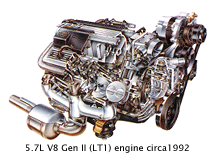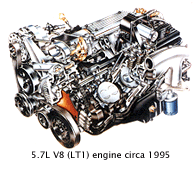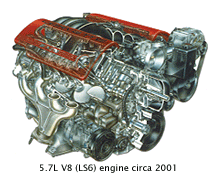Since 1955, Chevrolet has produced about 90 million small block V8s. That’s a huge number of engines, probably more than any other engine that’s ever been built. This engine’s amazing longevity and ongoing evolution has taken it from 265 cubic inches and 110 horsepower in 1955 to 427 cubic inches (7.0 liters) and more than 500 horsepower today (Corvette LS7).
Why did the Chevy small block V8 become so popular and why did it outlive most of its competitors? When the engine was first conceived, overhead valve pushrod engines had been around for some time. Chevrolet actually built its overhead valve V8 back in 1917. It was a 288-cubic-inch “Series D” engine rated at a measly 55 horsepower. It was a heavy, expensive engine and only a couple thousand were built before it was discontinued in 1919. Thereafter, Chevrolet built six-cylinder engines for its passenger cars up through 1954.
Early Muscle Days
In the early 1950s, V8 engines were all the rage. Ford’s low-cost flathead V8, which first appeared in 1932, helped popularize the V8 configuration with the American public. People liked the power and the smoothness of a V8 compared to a four- or six-cylinder engine. But flatheads were not very efficient engines because the valves were located in the block. This made the engine cheap to manufacture, but also restricted breathing and the performance potential of the engine. Even so, Ford flathead V8s were popular with hot rodders of that era because they were so abundant and because aftermarket companies made performance parts to “soup up” these engines.
 In 1949, General Motors got serious about overhead valve V8s with the introduction of an all-new engine for Cadillac. This was GM’s first “modern” mass produced V8 with high compression heads (7.5:1, which was high for the gasoline of those days), overhead valves and “lightweight” castings (200 lbs. lighter than the earlier Cadillac V8 engine it replaced). The 1949 Cadillac engine was an “oversquare” design with 3.81-inch bores and a 3.62-inch stroke, giving it a total displacement of 331 cubic inches. The engine was rated at 160 horsepower, which made it a more powerful, fuel efficient engine than any previous design. The engineering that went into the Cadillac engine set the stage for new engines that would later come from Buick, Oldsmobile, Pontiac and Chevrolet.
In 1949, General Motors got serious about overhead valve V8s with the introduction of an all-new engine for Cadillac. This was GM’s first “modern” mass produced V8 with high compression heads (7.5:1, which was high for the gasoline of those days), overhead valves and “lightweight” castings (200 lbs. lighter than the earlier Cadillac V8 engine it replaced). The 1949 Cadillac engine was an “oversquare” design with 3.81-inch bores and a 3.62-inch stroke, giving it a total displacement of 331 cubic inches. The engine was rated at 160 horsepower, which made it a more powerful, fuel efficient engine than any previous design. The engineering that went into the Cadillac engine set the stage for new engines that would later come from Buick, Oldsmobile, Pontiac and Chevrolet.
The Father of the Small Block
Even invention has an inventor, and the Chevy small block V8 is no exception. Though corporate engines are developed and built by teams of engineers, there’s always somebody at the top who gives the process direction and implementation. That man was Chevrolet’s chief engineer Ed Cole.
According to the book “Chevrolet 1955, Creating the Original” by Michael Lamm (a history of the development of the 1955 Chevy and small block V8), General Motors wanted to revamp Chevrolet’s image in the early 1950s. Chevrolet had become an “old man’s” car. Younger buyers (which are future repeat buyers) as well as hot rodders were buying Ford products. Their grandfathers were buying Chevrolets. So the brass at GM decided a new direction was needed for Chevrolet – a more youthful, performance-oriented image.
 In 1952, Chevrolet hired the guy who spearheaded the development of Cadillac’s new V8, Ed Cole. Cole was an engineer who not only understood where engine technology was heading, but who also was a racer at heart. He was a performance guy who wanted to build engines people would buy. He had a vision and a mission, and the opportunity that Chevrolet offered him was too much to resist.
In 1952, Chevrolet hired the guy who spearheaded the development of Cadillac’s new V8, Ed Cole. Cole was an engineer who not only understood where engine technology was heading, but who also was a racer at heart. He was a performance guy who wanted to build engines people would buy. He had a vision and a mission, and the opportunity that Chevrolet offered him was too much to resist.
When Cole took over as top engineer at Chevrolet, the first thing he did was throw out everything his predecessors had been working on for Chevrolet’s “next generation” engines. He wanted to build a lightweight, inexpensive engine using the latest technology, and to build an engine that would beat anything Ford had to offer. So he started with a clean sheet of paper and brought together all the key elements that would eventually create Chevy’s new small block V8.
In 1953, Chevrolet introduced the Corvette, America’s first sports car. The small block V8 was still in development, so the Corvette was initially powered by a “Blue Flame” six-cylinder with three carburetors. This was Chevrolet’s initial effort at turning around its image, but it was the 1955 Chevy that really changed things for Chevrolet thanks to the new V8.
Quick out of the Blocks
When the 1955 Chevy went on sale, the V8 was an immediate hit. Though the engine only displaced 265 cubic inches and came with a two-barrel carburetor giving it 162 horsepower, it was obvious the engine had serious performance potential. Soon thereafter, a four-barrel version with 185 horsepower was offered, followed by a dual four-barrel motor pumping out 225 horsepower. Those numbers may not sound like much by today’s standards, but at the time they were quite good. Within a couple of years, the new small block V8 would be putting out one horsepower per cubic inch (283/283) – a goal that had always eluded engineers and some thought may never be possible to achieve in a naturally aspirated engine.
 When Chevy engineers established the dimensions of the small block, they never dreamed that someday it would displace more than 400 cubic inches. At the time, there were no plans to enlarge the displacement much beyond the original 265 cubic inches. In fact, the engine was initially planned to displace 260 cubic inches with 3.75-inch bores and a 2.93-inch stroke. But they decided to round off the stroke to an even three inches, which pushed the displacement up to 265.
When Chevy engineers established the dimensions of the small block, they never dreamed that someday it would displace more than 400 cubic inches. At the time, there were no plans to enlarge the displacement much beyond the original 265 cubic inches. In fact, the engine was initially planned to displace 260 cubic inches with 3.75-inch bores and a 2.93-inch stroke. But they decided to round off the stroke to an even three inches, which pushed the displacement up to 265.
As casting techniques improved, Chevy engineers realized the small block had a lot of potential for growth. They could increase the bore size and the stroke to offer more displacement and power for larger cars or more performance. The 265 soon became a 283, then a 327, then a 350 and eventually a 400 with other sizes in between (302, 307, etc.). The flexibility of the original block and heads is one of the reasons the engine remained in production for so long and was produced in so many different configurations.
The interchangeability of parts, namely the cylinder heads, block, pistons and cranks, also allowed this engine to be built many different ways and to be installed in many different vehicles. The growing volume of engines that were being produced also meant that the small block Chevy V8 was plentiful and cheap, making it a natural choice for hot rodders, racers and aftermarket performance products. Eventually, it would become the most popular performance and racing engine of all time.
The compact size of the block (21.75 inches long and only 9 inches high from the oil pan rail to the cylinder heads) allowed the engine to fit almost anything. The block only weighed 531 pounds, which was 41 pounds less than Chevy’s in-line six-cylinder engine. This too, was a big advantage and attraction for many hot rodders and racers. The new block also required only 12 casting cores, compared to as many as 22 for other manufacturers’ blocks at the time. This reduced the cost of the engine and allowed the cylinders to be cast with greater precision.
The crossflow cylinder heads also proved to be very efficient and capable of producing significant horsepower with larger valves. The wedge-shaped combustion chambers could handle a lot of compression without experiencing detonation, and had enough meat to allow porting for increased airflow.
The new engine also proved to be quite durable. Chevy engineers opted to use a forged steel crankshaft and connecting rods rather than cast parts. This, combined with the lightweight valvetrain, allowed the small block to be a high revving, good performing engine.
Over the years, Chevrolet small block V8s have won more NASCAR, circle track, SCCA and drag racing events than any other manufacturer. This fact alone should attest to the engine’s popularity. In recent years, the availability of aftermarket performance blocks and heads to replace the OEM castings has helped continue and expand the popularity and versatility of the Chevy small block. This, in turn, continues to fuel the ongoing development of performance parts for these engines, which means more races won and more dominance for Chevrolet in most forms of racing.
Ongoing Evolution
The original “Gen I” Chevy small block enjoyed a production run of almost 40 years, from 1955 through 1991. In 1992, Chevy engineers decided it was time to make some major revisions in the original design, so they introduced the second generation “Gen II” small block in the Corvette. The new “LT1” engine looked pretty much the same and shared the same basic dimensions, but featured reverse-flow cooling, revised cylinder heads and a crank-triggered “Opti-Spark” distributor. Displacement remains at 350 cubic inches.
The LT1 engine replaced the previous L98 engine, and offered 509 more horsepower in the same-sized package. The engine had a cast iron block with aluminum cylinder heads. The reverse-flow cooling system routed coolant to the heads first rather than the block to stabilize head temperatures and to allow the block to run hotter (for less friction). The water pump on this engine was driven by a small gear behind the timing chain, rather than being belt-driven like every previous small block V8. The distributor was eliminated, replaced by the cam-driven Opti-Spark system on the front of the engine. This version of the small block was also Chevy’s first to come factory-filled with 5W-30 synthetic motor oil.
The Gen II V8 (LT1 and LT4 versions) powered various GM cars from 1992 to 1997. But as time marched on, so did technology. Chevrolet engineers decided it was time to totally redesign the small block.
Back to the Drawing Board
In 1997, the new C5 Corvette was equipped with a totally new small block dubbed the “Gen III.” The production designation was “LS1” and that soon became the label for Chevy’s new small block.
Like the original 265 small block V8, the LS1 was created from a clean sheet of paper. The only thing Chevy engineers wanted to retain from the original design was the bore spacing. The block, heads and manifolds are totally new (and NOT interchangeable with any of the earlier engines). The LS1 block is aluminum with cast-in-place iron liners. The most noticeable changes are the cylinder heads. Gone are the familiar siamese exhaust ports in the center of the heads. The LS1 heads look more like Ford heads with even spacing between all the intake and exhaust ports. The intake ports also have a unique shape with a tall, narrow configuration. The new design improves breathing and eliminates the hot spot between the two center cylinders that can sometimes lead to head gasket failure. The other major change is the firing order (1-8-7-2-6-5-4-3 in the new engine versus 1-8-4-3-6-5-7-2 in the older engines).
The latest renditions of the small block are the “Gen IV” engines that include the 6.0L LS2, the 5300 5.3L (LS4) with “displacement on demand,” and Vortec 5300 5.3L (LH6) for Chevy trucks. Displacement on demand deactivates up to four cylinders when the engine is under light load to improve fuel economy. Developed by Delphi, displacement on demand closes the intake and exhaust valves on targeted cylinders using special electronically controlled hydraulic lifters, and disables fuel and spark to those cylinders.
Years ago when overhead cam engines were all the rage, GM engineers said pushrod engines were here to stay. Why? Because pushrod engines offer the most efficient package for the price. A pushrod engine with two valves per cylinder develops good torque at low rpm and cost much less to build than an engine with overhead cams and three or four valves per cylinder. The pushrod engine, at least in GM’s opinion, remains the “bread-and-butter” engine for the masses. The small block Chevy V8 is no exception. This engine still come a long way over the past 50 years, and still has a long way to go.


